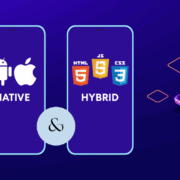Most Popular JavaScript Frameworks for 2025: A Comprehensive Guide
A recent report by Stack Overflow mentioned that about 64% of developers around the globe use JavaScript as their primary language. This increasing popularity of JavaScript is a testament to its wide range of applications and versatility in web and mobile app development practices.
JavaScript frameworks have transformed web and mobile app development, making it more efficient, faster, and scalable than ever. But with endless options available, choosing the right JavaScript framework can be a challenging task.
The right JavaScript framework can help you dominate the market by offering exceptional performance, flexibility, and community support.
In this comprehensive guide, we will explore the most popular JavaScript frameworks in 2025 along with their key features, empowering you to choose the right one for your next web development project.
Understanding JavaScript Frameworks
JavaScript frameworks refer to the collection of pre-written JavaScript code libraries that provide a base and structure for building web applications. By leveraging the most popular JavaScript frameworks, developers can efficiently save time by avoiding writing JS codes manually.
JavaScript frameworks offer reusable components, tools, and code libraries to streamline the development process and enable developers to create complex web applications efficiently. Also, JavaScript frameworks can be used efficiently for both front-end and back-end development.
8 Most Popular JavaScript Frameworks
JavaScript is undoubtedly the most widely used programming language and JavaScript frameworks dominate web development by streamlining the process like no other technology. Among these, several frameworks stand out as the most popular JavaScript frameworks due to their unique advantages.
Let’s have a look at the 10 best popular JavaScript frameworks that will dominate web and mobile app development in 2025 and beyond.
React.js
React.js, developed by Facebook, is an open-source and one of the most popular JavaScript frameworks for building active and responsive user interfaces. The component-based architecture of React.js allows developers to break down complex UIs into smaller, reusable pieces.
React.js can be prominently used to develop dynamic and interactive web applications due to its declarative programming style and virtual DOM.
Key Features of React.js:
- Unidirectional dataflow
- Compatibility with JSX (JavaScript Syntax Extension)
- Cross-platform performance
- Various reusable components
Next.js
Next.js is another popular open-source JavaScript framework that is ideal for front-end development. It is based on React and allows to build server-rendered React applications. Developers can create both static and dynamic JAMstack websites. Also, Next.js primarily supports both CSS and styled JSX.
Next.js is one of the most popular JavaScript frameworks because it makes web and app development more accessible and scalable.
Key Features of Next.js:
- Server-side rendering (SSR)
- Static site generation (SSG)
- Automatic Routing
- Built-in CSS support
Angular
Next on our list of the most popular JavaScript frameworks is Angular. Developed and maintained by Google, Angular is a comprehensive and powerful JavaScript framework. It allows developers to build web applications with a structured approach by providing a wide range of tools and features.
Angular is an ideal choice for developing large-scale enterprise applications due to its component-based architecture, two-way data binding, and dependency injection.
Key Features of Angular:
- Command-line interface (CLI)
- TypeScript support
- Instinctive and progressive API
- Strong community and ecosystem, backed by Google
Vue.js
Vue.js is a progressive, open-source JavaScript framework that is known for its flexibility and simplicity. It is widely used for cross-platform apps and websites. Also, Vue.js allows the development of powerful Single Page Applications (SPAs). Vue.js is a progressive framework and can be integrated with other JS libraries easily.
Vue.js can empower modern single-page web-based apps. It offers a simple and swift fix for user interface, apps, and engaging web-based interface development.
Key Features of Vue.js:
- Declarative programming style
- Component-based architecture
- Two-way data binding
- Virtual DOM
Node.js
A robust framework without which our list of the most popular JavaScript frameworks will be incomplete is Node.js. Released in 2009, Node.js is an open-source runtime framework that can run JavaScript browser-free and is intended to create network-based applications on a large scale.
Node.js is optimized for efficient resource management, making it distinct from other front-end development frameworks.
Key Features of Node.js:
- Compatible with other libraries and frameworks.
- Non-blocking thread execution
- Event-based model
- Fast code execution
Svelte.js
Svelte.js was released in 2016 and is a front-end JavaScript framework. Unlike traditional frameworks, Svelte creates smaller bundle sizes and delivers fast performance by compiling your components into highly efficient JavaScript code at build time. Also, Svelte doesn’t use virtual DOM like Vue and React.
Svelte.js is gaining popularity due to its simplicity and focus on providing a seamless developer experience, making it ideal for developing web applications.
Key Features of Svelte.js:
- Reactive programming
- Component-based architecture
- Converts code into Vanilla JavaScript
- Lightweight and easy to implement
Backbone.js
Backbone.js has made it into our list of most popular JavaScript frameworks due to its lightweight JavaScript library that uses the MVC (Model-View-Controller) architecture pattern. It offers diverse sets of building blocks, including precise views, explicit events, routers, and models, for creating web-based applications.
Backbone.js is mainly used for building single-page applications (SPAs) and client-side apps that run in a structured manner in web browsers.
Key Features of Backbone.js:
- Open-source library
- 100+useful extensions
- Lightweight and flexible
- Immense community support
Ember.js
Ember.js, initially known as SproutCore 2.0, is another commonly used open-source Javascript framework for developing single-page web apps. Ember.js is a web framework that uses the MVC (Model-View-Controller) architecture pattern, however, it can be used for desktop and mobile application development as well.
Ember.js mainly uses HTML and CSS for its development model and its backend architecture makes it feasible to write advanced HTML tags.
Key Features of Ember.js:
- Convention over Configuration (CoC) approach
- Rich documentation
- Strong community support
- Fast project setup with Ember CLI
Wrapping Up the Most Popular JavaScript Frameworks
JavaScript frameworks will continue to evolve in 2025 and beyond, offering more powerful and advanced tools for creating modern web, desktop, and mobile applications. When it comes to choosing the right JavaScript framework for your web development project, it mainly depends on project requirements, system compatibility, scalability, and the skills of the team building that project.
Looking ahead, frameworks like React, Angular, Vue.js, Svelte, Next.js, and others mentioned in our list of the most popular JavaScript frameworks will remain at the forefront of web development.




